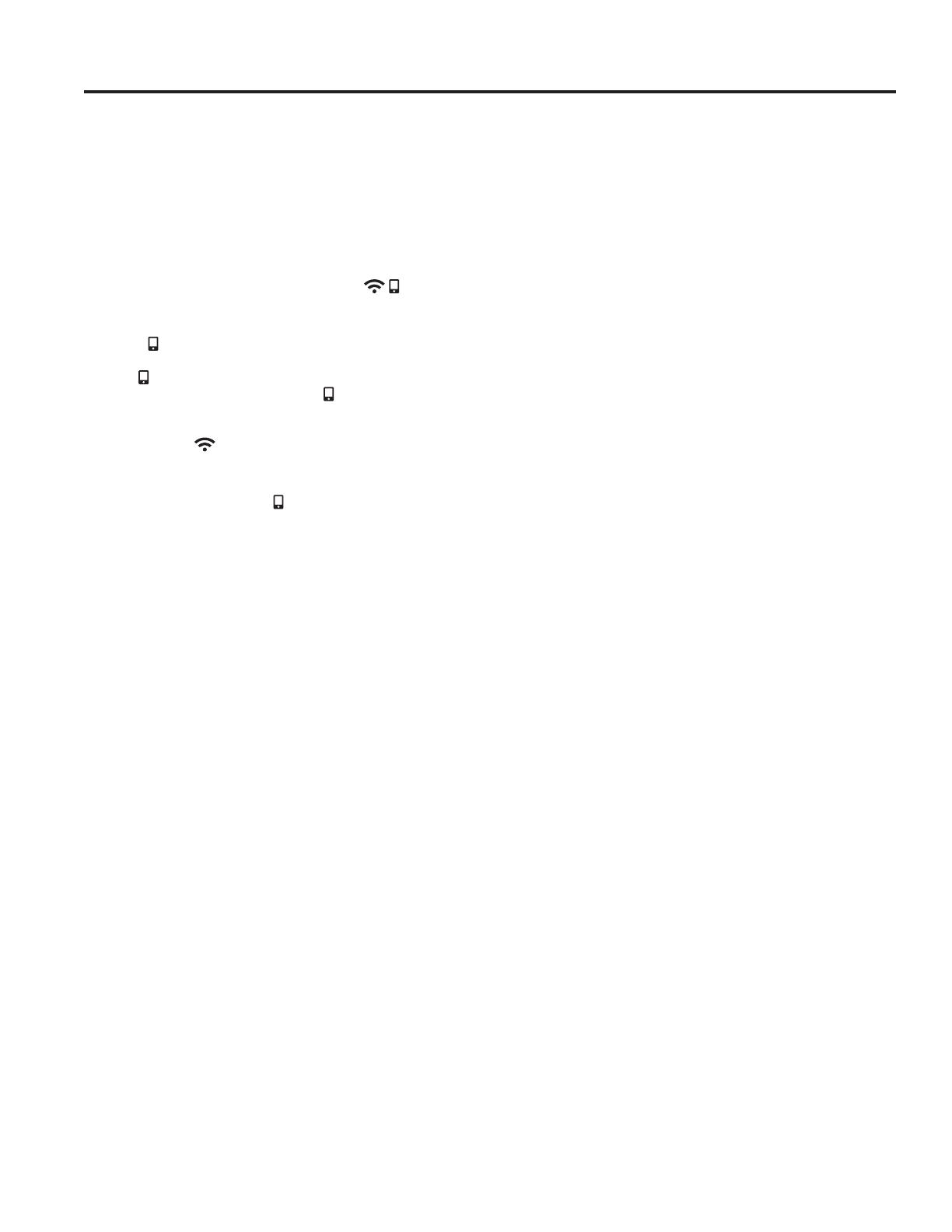
14 49-2000386 Rev. 2
Settings (Configuraciones) (Cont.)
USO DE LA COCINA: Settings (Configuraciones)
Conexión WiFi y Acceso Remoto (cont.)
Para conectar dispositivos inteligentes adicionales, realice la
desconexión de la red WiFi y el primer dispositivo, luego vuelva
a realizar la conexión a la red WiFi y repita los pasos 1 y 2. La
unidad sólo podrá ser conectada a un dispositivo por vez.
Observe que todos los cambios o modificaciones al dispositivo
de acceso remoto instalado en este horno que no están
expresamente aprobados por el fabricante podrían anular la
autoridad del usuario para operar el equipamiento.
INICIO DEL HORNO EN FORMA REMOTA
Para poder iniciar el horno en forma remota una vez conectado
a WiFi, presione la tecla Remote Enable (Acceso Remoto)
y el ícono se encenderá en la pantalla. El horno puede ser
iniciado ahora de forma remota con un dispositivo conectado.
El ícono deberá estar iluminado para iniciar el horno de
forma remota. No se requiere el ícono para modificar la
temperatura del horno mientras esté funcionando, configurar un
temporizador o apagar el horno desde la aplicación del teléfono
mientras el ícono muestre que está Conectado a WiFi.
Para desconectar su teléfono de Remote Enable (Acceso
Remoto Activado), presione la tecla Remote Enable (Acceso
Remoto Activado) y el ícono se apagará.
NOTA: Las comidas que se echan a perder rápidamente,
tales como leche, huevos, pescado, rellenos, ave y cerdo, no
se deberán dejar reposar por más de 1 hora antes y después
de la cocción. La temperatura ambiente estimula el desarrollo
de bacterias nocivas. Asegúrese de que la luz del horno esté
apagada, ya que el calor de la lámpara acelerará el crecimiento
de bacterias nocivas.
Clock (Reloj)
Esta configuración ajusta el tiempo del reloj del horno. Presione
la tecla Settings (Configuraciones) y seleccione Clock
(Reloj). Seleccione Set Clock (Configurar Reloj) y siga las
instrucciones para configurar el reloj. Esta función también
especifica cómo se mostrará la hora del día. Puede seleccionar
el reloj con hora estándar de 12 horas (12 H), la hora militar
de 24 horas (24 H), o que no se exhiba ningún reloj (Off)
(Apagado). Presione la tecla Settings (Configuraciones),
seleccione Set Clock (Configurar Reloj) y seleccione la
opción 12/24 u On/Off (Encender/ Apagar).
Bluetooth
®
- Chef Connect
Se trata de una función de emparejamiento para uso con otros
productos compatibles con Chef Connect, tales como un horno
microondas para uso sobre la cocina o una campana de cocina.
A fin de emparejar estos productos a la cocina, presione la
tecla Settings (Configuraciones) y seleccione Bluetooth
®
.
Seleccione Pair (Emparejar) y siga las instrucciones
correspondientes incluidas con el producto de emparejamiento
permitido por Chef Connect. La cocina cancelará el modo de
emparejamiento luego de dos minutos, si no es detectado ningún
dispositivo para emparejar. Seleccione Remove (Retirar) para
confirmar que el producto está emparejado o para desemparejar
el mismo de su cocina. La Sonda de Cocción de Precisión
también puede ser emparejada usando la función Bluetooth
®
.
Auto Conv (Conversión Automática)
$OXVDUODVRSFLRQHVGHFRFFLyQ&RQYHFWLRQ%DNH+RUQHDU
por Convección) o Convection Roast (Dorar por Convección),
Auto Recipe Conversion (Conversión de Receta Automática)
convertirá de forma automática las temperaturas de horneado
regular ingresadas a temperaturas de cocción de horneado
por convección cuando se active. Se debe observar que esta
opción no convierte los tiempos de cocción del horneado por
convección, sino sólo las temperaturas. Esta función podrá ser
encendida o apagada. Seleccione Settings (Configuraciones),
Auto Conversion (Conversión Automática) es la quinta opción
y aparece en la primera pantalla de configuraciones, y Auto
Conversion (Conversión Automática), y luego siga las
indicaciones para activar o desactivar esta función.
Auto Off (Apagado Automático)
Esta función apaga el horno luego de 12 horas de funcionamiento
continuo. Podrá estar activada o desactivada. Seleccione
Settings (Configuraciones), More (Más), y Auto Off (Apagado
Automática) para activar o desactivar esta función.
Sound (Sonido)
Podrá ajustar el volumen y el tipo de alerta que su dispositivo
utilice. Seleccione Settings (Configuraciones), More (Más),
y Sound (Sonido). Siga las instrucciones para realizar ajustes
de volumen o para cambiar entre tonos de alerta continuos o
simples. Una configuración continua seguirá haciendo que un
tono suene hasta que un botón del control sea presionado. El
volumen del tono del horno podrá ser ajustado. El control hará
que el tono del horno suene en el nuevo nivel de volumen cada
vez que el nivel de sonido sea modificado.
F/C (Fahrenheit o Celsius)
El control del horno está configurado para su uso con
temperaturas Fahrenheit (F), pero puede ser modificado
a temperaturas Celsius (C). Seleccione Settings
(Configuraciones), More (Más), y F/C para alternar entre las
escalas de temperatura exhibidas.
Adjust the Oven temperature (Ajuste de la
Temperatura del Horno)
Esta función permite que la temperatura de horneado del horno
y de horneado por convección sean ajustadas hasta 35°F más
caliente o 35°F más fría. Use esta función si considera que la
temperatura de su horno está demasiado caliente o demasiado
IUtD\GHVHDPRGLILFDUOD(VWHDMXVWHDIHFWDORVPRGRV%DNH
+RUQHDU\&RQYHFWLRQ%DNH+RUQHDUSRU&RQYHFFLyQ1R
modifica los modos Proof (Leudar) o Cleaning (Limpieza).
Seleccione Settings (Configuraciones) y Oven Adjust
(Ajuste del Horno) para agregar More Heat (Más Calor) o
Less Heat (Menos Calor) y luego presione Save (Guardar).
Oven Info (Información del Horno)
Seleccione Settings (Configuraciones), More (Más), y Oven
Info (Información del Horno) para activar o desactivar esta
función. Esta configuración muestra el Número de Modelo y la
Versión del Software.








































































